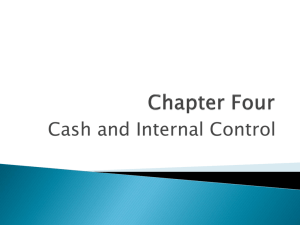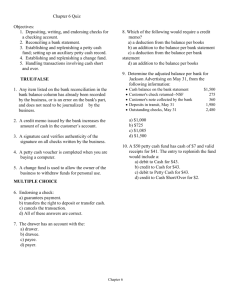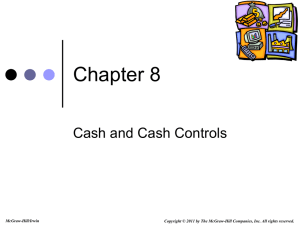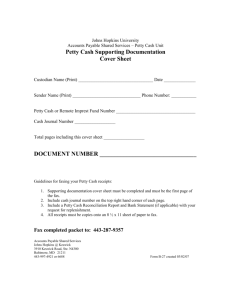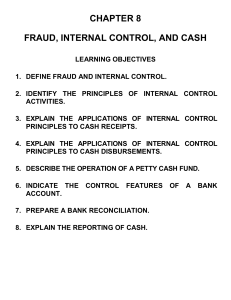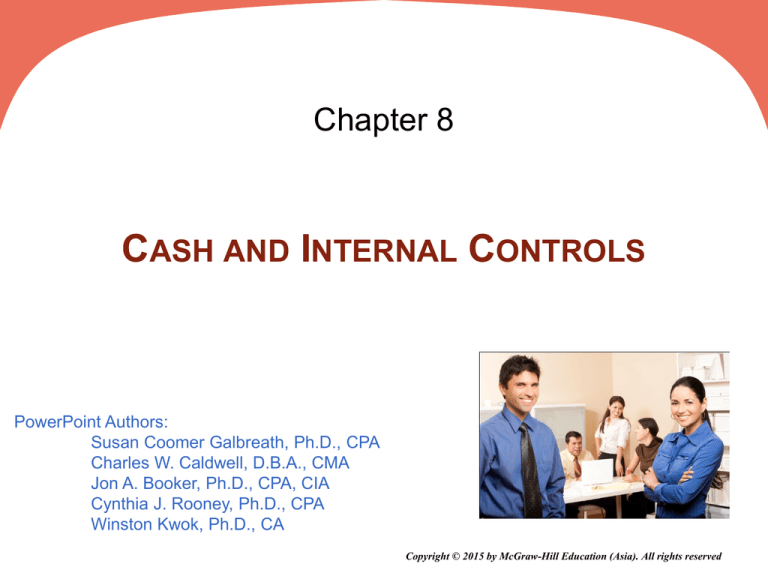
Chapter 8
CASH AND INTERNAL CONTROLS
PowerPoint Authors:
Susan Coomer Galbreath, Ph.D., CPA
Charles W. Caldwell, D.B.A., CMA
Jon A. Booker, Ph.D., CPA, CIA
Cynthia J. Rooney, Ph.D., CPA
Winston Kwok, Ph.D., CA
Copyright © 2015 by McGraw-Hill Education (Asia). All rights reserved
8-2
C1
INTERNAL CONTROL SYSTEM
Policies and procedures managers use to:
Protect assets.
Ensure reliable accounting.
Promote efficient operations.
Urge adherence to company policies.
8-3
C1
PRINCIPLES OF INTERNAL CONTROL
Internal control principles common to all companies:
1.
Establish responsibilities.
2.
Maintain adequate records.
3.
Insure assets and bond key employees.
4.
Separate recordkeeping from custody of assets.
5.
Divide responsibility for related transactions.
6.
Apply technological controls.
7.
Perform regular and independent reviews.
8-4
C1
TECHNOLOGY AND INTERNAL CONTROL
Reduced
Processing
Errors
More
Extensive Testing
of Records
Limited
Evidence of
Processing
Crucial
Separation of
Duties
Increased
E-Commerce
8-5
C1
LIMITATIONS OF INTERNAL CONTROL
Human Error
Human Fraud
Negligence
Fatigue
Misjudgment
Confusion
Intent to
defeat internal
controls for
personal gain
Human fraud triple-threat:
Opportunity, Pressure, and Rationalization.
8-6
C1
LIMITATIONS OF INTERNAL CONTROL
The costs of internal controls
must not exceed their benefits.
Benefits
Costs
8-7
C2
CONTROL OF CASH
An effective system of internal control that
protects cash and cash equivalents should meet
three basic guidelines:
Handling cash
is separated from
recordkeeping of
cash.
Cash receipts
are promptly
deposited in a
bank.
Cash
disbursements
are made by
check.
8-8
C2
CASH, CASH EQUIVALENTS,
AND LIQUIDITY
Cash and similar assets are called liquid assets because
they can be readily used to settle such obligations.
Cash
Currency, coins and amounts on deposit in bank accounts,
checking accounts, and some savings accounts. Also
includes items such as customer checks, cashier checks,
certified checks, and money orders.
Cash Equivalents
Short-term, highly liquid investments that are:
1. Readily convertible to known amounts of cash.
2. Subject to an insignificant risk of changes in value.
8-9
C2
CASH MANAGEMENT
The goals of cash management are twofold:
1.
Plan cash receipts to meet cash payments when due.
2.
Keep a minimum level of cash necessary to operate.
Effective cash management involves applying
the following cash management principles:
Encourage collection of receivables.
Delay payment of liabilities.
Keep only necessary levels of assets.
Plan expenditures.
Invest excess cash.
8 - 10
P1
OVER-THE-COUNTER CASH RECEIPTS
This graphic illustrates that none of the people
involved can make a mistake or divert cash
without the difference being revealed.
8 - 11
P1
CASH OVER AND SHORT
Sometimes errors in making change are discovered from
differences between the cash in the cash register and the
record of the amount of cash receipts.
If a cash register’s record shows $550 but the count of cash
in the register is $555, we would prepare the following journal
entry:
8 - 12
P1
CASH RECEIPTS BY MAIL
Preferably, two
people are
assigned the
task of opening
the mail.
The cashier
deposits the
money in a
bank.
The
recordkeeper
records the
amounts
received in the
accounting
records.
Mailroom
Cashier
Recordkeeper
8 - 13
P1
CONTROL OF CASH DISBURSEMENTS
Control of cash disbursements is especially
important as most large thefts occur from
payment of fictitious invoices.
Keys to Controlling Cash Disbursements
Require all expenditures to be made by check.
Limit access to checks except for those who
have the authority to sign checks.
8 - 14
P1
VOUCHER SYSTEM OF CONTROL
A voucher system establishes procedures
for:
1. Verifying, approving, and recording
obligations for eventual cash disbursements.
2. Issuing checks for payment of verified,
approved, and recorded obligations.
8 - 15
P1
VOUCHER SYSTEM OF CONTROL
8 - 16
P2
PETTY CASH SYSTEM OF CONTROL
Small payments required in most companies
for items such as postage, courier fees,
repairs, and supplies.
8 - 17
P2
OPERATING A PETTY CASH FUND
Petty Cash
Company
Cashier
Accountant
Petty
Cashier
8 - 18
P2
OPERATING A PETTY CASH FUND
Petty
Cashier
Petty Cash
8 - 19
P2
OPERATING A PETTY CASH FUND
A petty cash fund is
used only for
business expenses.
Petty
Cashier
Transportation-in Services
Supplies
Delivery
8 - 20
P2
OPERATING A PETTY CASH FUND
Petty
Cashier
Petty cash receipts
with either no signature
or a forged signature
usually indicate misuse
of petty cash.
Transportation-in Services
Supplies
Delivery
8 - 21
P2
OPERATING A PETTY CASH FUND
$71.30
Company
Cashier
Accountant
To reimburse
petty cash fund
Petty
Cashier
8 - 22
C2
BASIC BANK SERVICES
Bank Accounts
Checks
Signature Cards
Deposit Tickets
Electronic
Funds Transfer
Bank
Statements
8 - 23
C2
BANK STATEMENT
Usually once
a month, the
bank sends
each
depositor a
bank
statement
showing the
activity in the
account.
8 - 24
P3
BANK RECONCILIATION
A bank reconciliation is prepared periodically to explain
the difference between cash reported on the bank
statement and the cash balance on company’s books.
8 - 25
P3
BANK RECONCILIATION
The balance of a checking account reported on
the bank statement rarely equals the balance in
the depositor’s accounting records.
Cash Balance per Bank
Cash Balance per Book
+ Deposits in Transit
+ Collections & Interest
- Outstanding Checks
- Uncollectible items
+/- Errors
+/- Errors
Adjusted Cash Balance
Adjusted Cash Balance
=
Adjusting entries are recorded for the reconciling items on
the book side of the reconciliation.
8 - 26
P3
ILLUSTRATION OF A BANK RECONCILIATION
We follow nine steps in preparing the
bank reconciliation.
Cash Balance per Bank
+ Deposits in Transit
- Outstanding Checks
+/- Errors
Adjusted Cash Balance
8 - 27
P3
ILLUSTRATION OF A BANK RECONCILIATION
We follow nine steps in preparing the
bank reconciliation.
Cash Balance per Book
+ Collections & Interest
- Uncollectible items
+/- Errors
Adjusted Cash Balance
8 - 28
P3
ILLUSTRATION OF A BANK RECONCILIATION
We follow nine steps in preparing the
bank reconciliation.
Adjusting entries are recorded for the reconciling
items on the book side of the reconciliation.
8 - 29
P3
ILLUSTRATION OF A BANK RECONCILIATION
Only the items reconciling the book balance
require adjustment.
8 - 30
A1
DAYS’ SALES UNCOLLECTED
Indicates how much time is likely to pass before
we receive cash receipts from credit sales.
Days’
=
Sales
Uncollected
Accounts Receivable
Net Sales
× 365
8 - 31
P4
APPENDIX 8A:
DOCUMENTATION AND VERIFICATION
Purchase Requisition
Purchase Order
Invoice
Receiving Report
Voucher
8 - 32
P5
APPENDIX 8B:
CONTROL OF PURCHASE DISCOUNTS
The net method gives management an advantage in
controlling and monitoring cash payments involving
purchase discounts.
When purchases are
recorded at net amounts,
a Discounts Lost expense
account is recorded and
brought to
management’s attention.
8 - 33
END OF CHAPTER 8


